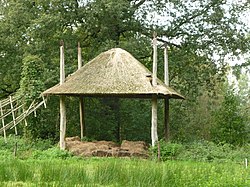Haystack  The haystack[1] is a type of construction which is a feature typical of the calid European countries. It consists of a central wooden pole with stacked hay layers around it, forming a heap for later transfer to the barn. A small wall used to be build around the haystack to prevent the cattle approaching it to eat the hay. At present, with the use of machinery, such storage has been replaced by "bales" of straw. TypesHaystacks, first used for loose hay, probably since the beginnings of livestock farming in the Neolithic period, were used from the 1860s for sheaves of cereals and then for low-density bales of hay or straw.
In its early days, silage was sometimes made in haystacks which were then loaded with an impermeable material. In Quebec, a stack silo is the equivalent of a molehill silo[2] Description The loose hay was transported to a designated area for collection -usually a slightly raised area to allow the water to be drained-, where the haystack (or pile of hay) was to be formed. The haystack was made waterproof (a task that needed a considerable skill) by compressing the hay under its own weight and with the heat released by the residual moisture helping the compression forces. The cell was surrounded by a fence to separate it from the rest of the field. When needed, the haystack was opened with the help of a knife and every day part of hay was used to feed the animals. Depending on the area, the haystack could be supported on an internal structure having a waterproof cover that could be lowered as hay retreated. Haystacks are also sometimes called haycocks; among some users this term refers more specifically to small piles of cut-and-gathered hay awaiting stacking into larger stacks.[3] The words (haystack, haycock) are usually styled as solid compounds, but not always. Haystacks are also sometimes called stooks, shocks, or ricks. Loose stacks are built to prevent the accumulation of moisture and promote drying or curing. In some places, this is accomplished by constructing stacks with a conical or ridged top.[4][5] The exterior may look gray on the surface after weathering, but the inner hay retains traces of its fresh-cut aroma and maintains a faded green tint.[4] They can be covered with thatch,[5][6] or kept within a protective structure. One such structure is a moveable roof supported by four posts, historically called a Dutch roof, hay barrack, or hay cap.[6][7] Haystacks may also be built on top of a foundation laid on the ground to reduce spoilage, in some places made of wood or brush.[4] In other areas, hay is stacked loose, built around a central pole, a tree, or within an area of three or four poles to add stability to the stack.[8][9][10] Haystacks for dryingAfter collection, the hay is gathered into small haystacks, on fairly raised areas to avoid stagnant water, possibly on old hay or straw to prevent mold. These areas may include a central wooden pole around which the hay is placed in tiles in successive rings o protect against the rain. In some regions with rainy climates, the hay was placed on a wooden base and a hat was added to form a roof of adjustable height which was lowered as it was used. This principle was modernized in the 1970s with the hay tower, without success.[11] Large haystacksThey are used for permanent outdoor storage, near the farm. They are erected according to the same principle : successive beds tiling and ending with the conical cap. When the hay is dry, a fence may be built to enclose the haystack and prevent roaming animals from eating it,[4][12] or animals may feed directly from a field-constructed stack as part of their winter feeding.[13] Modern haystacksTraditional haystacks disappeared with the introduction of medium-density bales, but today bales of dry hay or straw are sometimes stacked outdoors and covered with polyethylene film, sometimes then loaded with bales of straw. Compared to a shed, this is a less secure storage method (not to be confused with a storage tunnel ), the hay must be perfectly dry, but economical [14] since there is no building construction. The main disadvantage remains the additional work which is difficult to carry out by one person alone [15] . Spontaneous combustionHay stacked before it is fully dry can produce enough heat to start a fire. Farmers have to be careful about moisture levels to avoid spontaneous combustion, which is a leading cause of haystack fires.[16] Heat is produced by the respiration process, which occurs until the moisture content of drying hay drops below 40%. Hay is considered fully dry when it reaches 20% moisture. Combustion problems typically occur within five days to seven days of stacking. A haystack cooler than 120 °F (49 °C) is in little danger, hay between 120 and 140 °F (49 and 60 °C) need to be removed from haystacks or other structures and separated so that they can cool off. If the temperature of a haystack exceeds more than 140 °F (60 °C), it can combust.[17] Gallery
See alsoReferences
External linksWikimedia Commons has media related to Haystacks. |





















